Updated Summer 2023
Tubeless Conversion Index Page
Michelin TPMS review
It’s not impossible to get a bit cynical about the flood of gimmicky gadgets, products or optional features which modern technology has enabled, not least when associated with ‘adventure’ + ‘motorcycling’. But I believe that for the:
• price
• ease of fitting and
• non-interfering redundancy
a wireless Tyre Pressure Monitoring System is a worthwhile addition to your bike, whatever you do with it.
For as long as I’ve been on the road, tyre makers and road safety tsars have harped on about the importance of maintaining correct tyre pressures. They’re right of course: doing so is a major contribution to road safety for the reasons illustrated vividly in the videos below. But modern bike tyres are so good that I’ve often inadvertently ridden on drastically under-inflated tyres for weeks and not even noticed.
Add the fact that on some bikes the valves can be awkward to access with tyre gauges which themselves are hard to read or flakey in les developed countries. Plus it’s all grubby down there and your knees/back are no longer like Nureyev in his prime. Unless you’re a certain type of ATGATT swot, for day-to-day riding it’s all a bit of a faff to check tyre pressures as regularly as they advise. And yet your bike’s other vital signs: oil pressure, battery charge, temperature, lights and even which gear you’re in – are all conveniently lit up right there on the dash.
Tyre Pressure Monitoring System
The problem has always been how to read the pressure inside a tyre that’s spinning around at 1050rpm. Solution: inexpensive wireless technology. A TPMS is ingeniously composed of two replacement valve caps fitted with centrifugally activated pressure sensors.
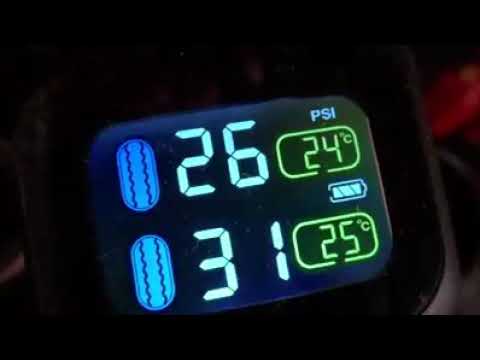
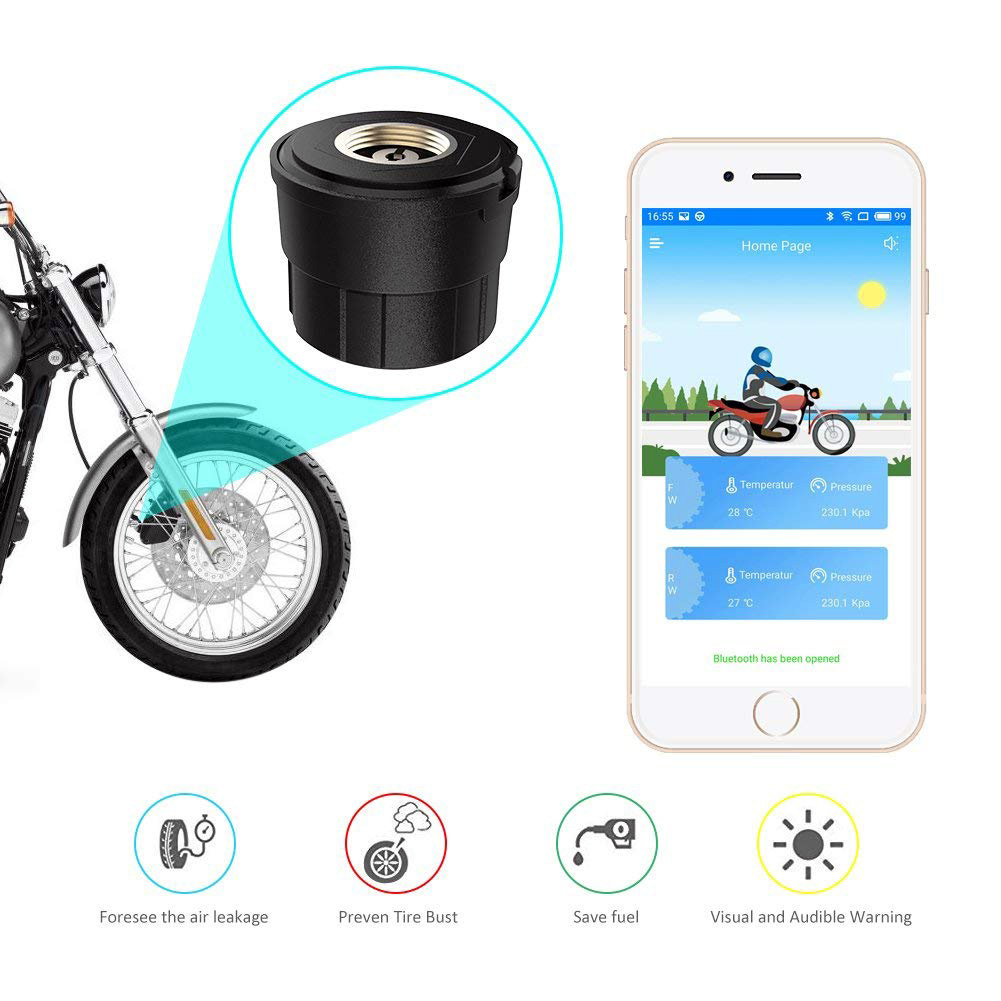
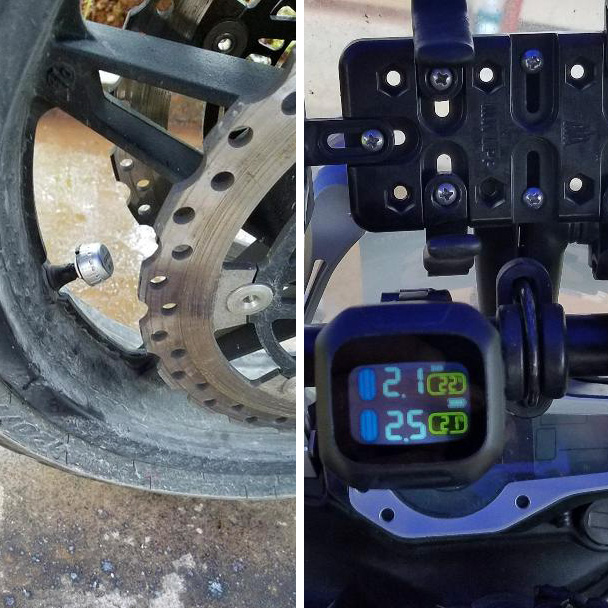
They pair wirelessly with a watch-sized display mounted where you can see it (or beamed to your indispensable smartphone; right). The TPMS display is either powered off the bike’s battery or is rechargeable in some way, so it’ll work on anything else with a regular Schrader valve, even a pushbike.
Result: real-time tyre pressure and even temperature monitoring (right). And best of all, the USB rechargeable ones like the Michelin-branded one I tried, don’t interfere with the bike’s systems in any way. If the caps play up, just refit the old ones. They weigh as little as 8 grams so are unlikely to cause tyre-balancing issues at normal road speeds.
Over the years I’ve found DIY, as well as other tubeless conversions like Tubliss and BARTubeless, have gradually lost air pressure faster than a regular tyre, tubed or OEM tubeless. And this is even when not run at very low psi where the tyre could conceivably ‘burp’ out some air over a bump. With any sort of DIY tubeless conversion, I highly recommend fitting a TPMS; certainly in the early days until you know how good the seal is.

Tyre pressures increase with elevation as ambient pressure falls, but they also drop as temperatures fall. For every 2000 feet (600m) you climb, the pressure will increase by 1 psi and will fall by the same amount for every drop of 4°C (10°F). But as temperatures naturally drop with elevation, things kind of balance themselves out.

Riding Off-Road
As we all know, lowering tyre pressures greatly improves traction on loose surfaces and can transform a bike from a mindless shopping trolley into a hyper-sapient roller blade. But when you lower tyre pressures, temperatures in the tyre carcass soar as it flexes and influxes much more on each rotation, just as you get hot exercising because your muscle tissue is rubbing. And as tyres heat up pressure readings climb. (This is why cold tyre pressures should be your baseline). In this hot, rubber-softened state a tyre is much more prone to punctures and other woes.

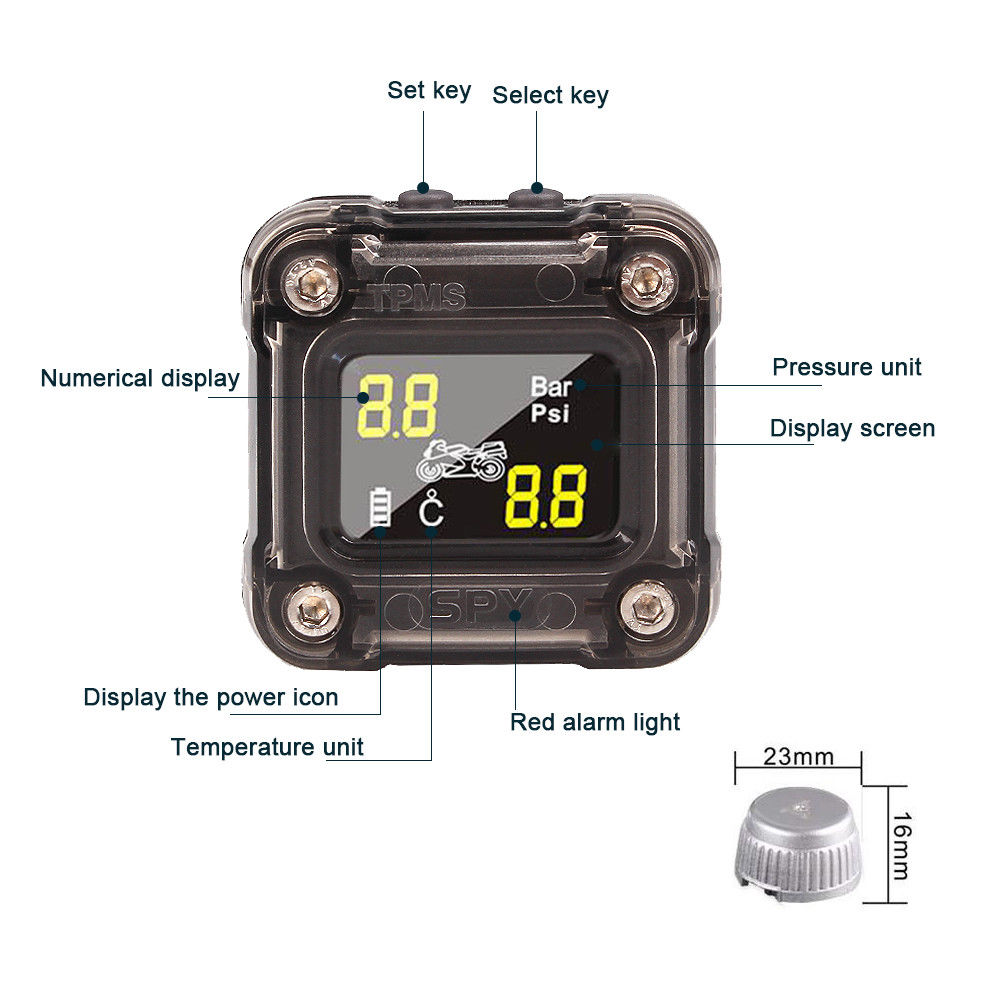
Off-road I tend to keep pressures as low as necessary but as high as possible. Usually erring on the high side at the cost of a comfy ride, so weary am I of repairing flats on tubed tyres in the middle of nowhere (left).
A TPMS won’t stop punctures but at least you’re able to observe how pressures climb from a cold start and what they’re actually doing on the dirt, so helping eliminate the guesswork of ‘press valve for 2-3 seconds’ or the nagging feeling of ‘should I stop and inflate a bit?’
You can buy obscure-brand TPMS kits for your bike off ebay from £30 for the smartphone-only ones. About £50 seems a good price for a decent one. Here’s an Advpulse review on a hardwire Cyclops TPMS (above left) which sells in the US for $130. Cyclops aren’t tyre specialists, they just sell gadgets and a near-identical looking kit can be bought on ebay UK for about half that price (above right).
A TPMS is one gadget I wish I’d had on my Tenere back in 2007, if not all my desert bikes over the years. I fitted Michelin’s one to my all-tubeless Himalayan and semi-tubeless Africa Twin in 2020. Read the review.




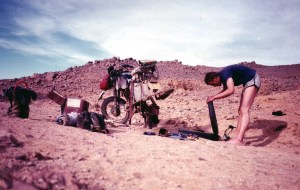

Vested interest here because I sell TPMS for trucks. The retrofit ones have two problems. First the cheap ones suffer valve failures. Second, the valve neck can be too weak. A metal replacement neck or internal sensor and standard valve is best. There is a good reason it will be mandated on all vehicles within 10 years, it will save lives.
LikeLike
Thanks for the tip, Andrew. I can imagine cheap TPMS valve caps failing (tho’ a mate has had no probs with his, afaik).
By neck I realise you mean the metal valve body as used on inner tubes andpictured here
as opposed to black rubber/plastic ones you get on cars
Internal sensors, so much the better – presume most easily inside TL wheels.
Anyway, I am reassured Michelin have put their name to a self-fit set.
Happy to see TPMS become a standard feature. Much more useful on a travel bike than TC, leaning ABS etc, etc.
LikeLike
Neat idea, but that looks like a fairly hefty chunk to screw onto a standard (and in this case vertical) valve. Any issues with balancing? Safe to use on angled valves?
LikeLike
Good reminder about balancing, but I suspect they’re just a few grams heavier than a regular cap.
I guess a fully perpendicular valve on a slim rim will always be more vulnerable on rocky terrain.
At worst it will bash and break the cap. You can buy replacements, or just remove it.
LikeLike